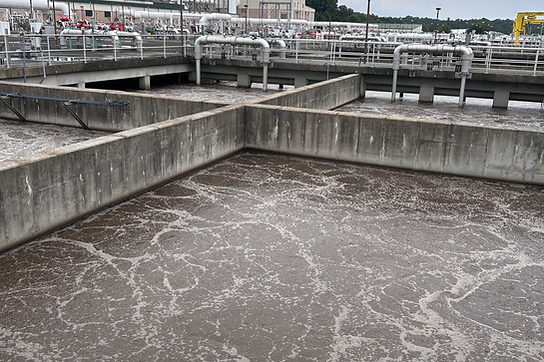
THE MELODIES OF MATERIALS
Materials science is at the heart of innovation, shaping the tools and technologies of our modern world. Let's dive into the intricacies behind the materials that define the music and sounds of our lives.
9/29/2025 ⋅ By Rishi Pai ⋅ 6 min read
Sustainability for the Future: Tour of the F. Wayne Hill Water Resources Facility

Final Steps of the Purification Process
I recently received the unique opportunity to take a full, immersive tour of the F. Wayne Hill Water Resources Facility, a part of The Water Tower, in Buford, Georgia. The plant serves as the heart of sustainable water resources for vast portions of the Metropolitan Atlanta area. As a part of the MARC (Model Atlanta Regional Commission) high school leadership and urban planning program, each program day provides a new insight on the governance, sustainability, and maintenance of the Metro Atlanta that we all know and love today, and this day taught us all about the world of sustainable energy and water resources that our city and state uses.
It’s astonishing that I live so close to one of the cleanest and most effluent wastewater plants in the entire country. Although I was aware of this facility for the longest time, I never really knew or understood exactly what the location did, nor did I know its profound and unique impact. The F. Wayne Hill Water Resources Center is located in Buford, a city in Gwinnett County, and it cleans and returns cleaned wastewater to surrounding areas of Metro Atlanta. It serves as a “worldwide model for wastewater treatment.” (Gwinnett County). Namely, it returns water to Lake Lanier, a reservoir in North Georgia that serves as the state’s largest source of water. Regarding the plant's uniqueness, this facility utilizes the ozone, granular activated carbon, and membrane treating processes that are some of your most innovative and efficient wastewater techniques. Let’s see how this plant is a story of materials and sustainability!
Scale and Materials Everywhere
My first impressions of this plant were certainly astounding. Seeing all of the massive digesters, the sprawling tanks, and the endless piping, I truly could not wrap my head around the complex work behind the clean water that I drink and use everyday. This experience further provided me with proof that materials are everywhere. I realized that the function, durability, and reliability of this plant that has served my area since 2000 is backed by some of the most strong and efficient materials. Reinforced concrete dominated many of the structures, with thick slabs and walls that had to resist constant exposure to moisture and chemicals. Steel was everywhere, coated to stave off rust. Plastic piping, like PVC and HDPE, ran alongside heavier ductile iron and stainless steel lines. Each of these materials played a part in the plant’s story.
At the F. Wayne Hill Water Resources Facility, the cleaning process is a step-by-step journey that turns dirty wastewater into clear, reusable water. First, large debris like sticks and plastics are caught on metal screens, and sand or grit settles out in chambers. Then, giant concrete tanks full of microbes break down the waste, with special coatings protecting the tanks from all the harsh chemicals. After that, the water is pushed through extremely fine membranes of reverse osmosis and treated with ozone gas to kill anything left behind, which means all the pipes and seals have to be made from materials that can handle strong oxidizers. Meanwhile, nutrients like phosphorus are recovered in the form of crystals that can be used as fertilizer, and leftover sludge is spun in centrifuges and dried, with heavy-duty metals and heat-resistant materials keeping the equipment from wearing out. By the end, what started as sewage is clean enough to be returned to the environment or reused: a process that works only because the right materials keep everything running. This plant is truly a living laboratory for materials constantly working and under stress.
Right next to the treatment plant sits the Gwinnett Environmental & Heritage Center, a building that wears its sustainability on its sleeve. With a living green roof, waterless fixtures, daylight harvesting, and recycled regional materials, it shows visitors the visible side of green design. In contrast, the F. Wayne Hill facility practices a quieter form of sustainability, which is hidden in the concrete mixes, coatings, and membranes that keep the plant running. Together, the two structures show us how materials, whether in infrastructure or architecture, shape our sustainable future.

Biological Treatment
Reflections and Future Outlook
As we left the facility, I kept thinking about the invisible battles being fought every day inside all of the tanks and pipes. Corrosion, scaling, abrasion, biological attack: these forces never rest. The materials that hold up against them are the unsung heroes of water sustainability.From insightful lectures from sustainability professionals, I realized that every drop of treated water is a story of sustainable material resilience. Without durable, well-chosen materials, there is no sustainability, only endless repair and replacement. With such materials, however, wastewater plants transform from hidden utilities into engines of reclamation that benefits both the people and the planet.So, the next time I turn on the tap, I will definitely spare a thought for the materials that are quietly in the background. Because at places like the F. Wayne Hill Water Resources Facility, sustainability is written all over in materials, just as much as it is in water. This is just the beginning of my journey in sustainability, and I hope to tour and see many more places, not only just in my area, where the “invisible” and “visible” sides to sustainability work hand in hand, reminding us that every material choice counts. But until dhin . . . stay upbeat and stay tuned.
Sources + where you can learn more: